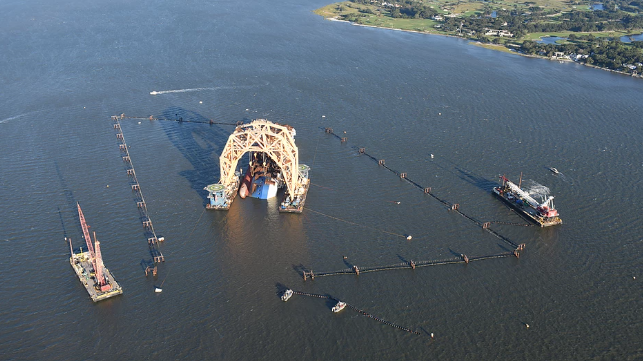Video: Golden Ray Wreck Cutting Begins

After a long series of delays, salvors have finally begun the process of cutting the capsized ro/ro Golden Ray into sections with a chain and a giant heavy lift barge.
The cutting operations for the first section of the wreck began at about 1030 hours on Friday morning, according to the Georgia Department of Natural Resources. The Unified Command (UC) for the response estimates that cutting and hoisting each section will take 24 hours.
The process of slicing a ship into transverse sections using an anchor chain generates significant amounts of noise, and responders are monitoring sound levels at the wreck site, St. Simons Island Pier and Jekyll Island Pier. Oil and debris recovery and firefighting teams will be on station.
The capsized cargo ship, Golden Ray, off the GA, coast is being cut into pieces by a chain. The worlds largest water crane will then lift the pieces for salvage removal. The guy running the project is a former operator. Good luck. pic.twitter.com/opK59snhCf
— Javier Goya (@JavierGoya7) November 6, 2020
“We expect there will be noise, fires, product discharges, and debris once we begin the cutting and lifting process. It would be unrealistic to say that this operation will be clean and perfect,” said State On-scene Coordinator John Maddox of the Georgia Department of Natural Resources. “We installed a multi-layer environmental protection system and have practiced prevention and response strategies for several months. We are prepared to protect the community and environment of St. Simons Sound.”
The 150-yard safety zone around the environmental barrier and work area has been increased to 200 yards for recreational vessels, and the unified command advises mariners to steer clear of the perimeter. The responders have banned any unauthorized use of drones around the wreck site.

that matters most
Get the latest maritime news delivered to your inbox daily.
The Golden Ray partially capsized during a starboard turn while outbound in St. Simons Sound in September 2019, coming to rest on her port side on a soft bottom. The cause of the casualty has not yet been formally established, but in September, a naval architect with the Coast Guard's Marine Safety Center testified that the vessel did not have sufficient ballast water in her tanks for the amount of cargo she had on board.
“The cause of the vessel capsizing was lack of righting energy due to the way the vessel was loaded . . . The vessel could have taken on additional ballast to be in compliance," testified Lt. Ian Oviatt of the USCG Marine Safety Center.
